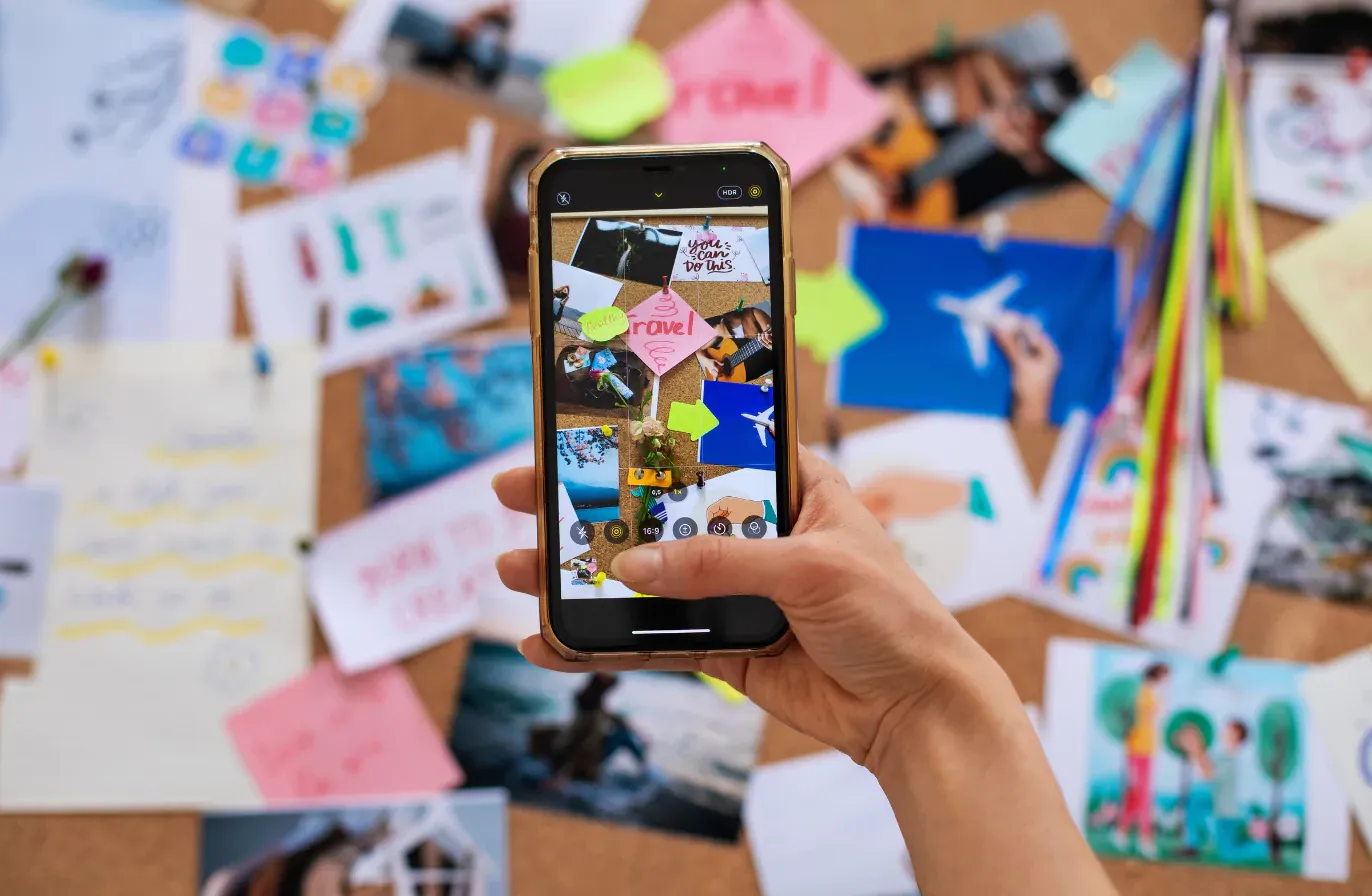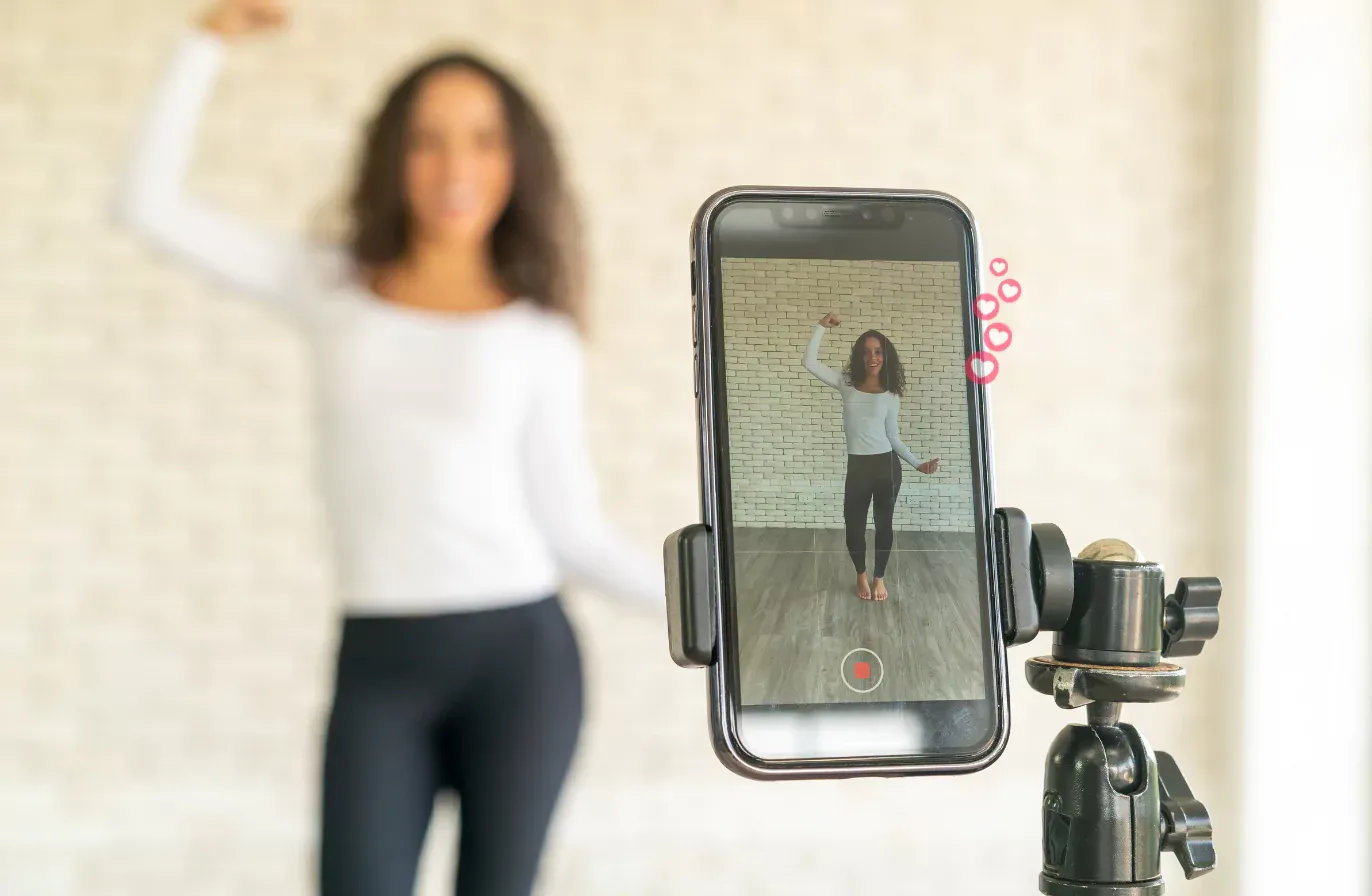Major Shifts in Social Media Consumer Behavior Nowadays
Delve into the dynamics of social media consumer behavior, examining how online interactions shape purchasing decisions and brand loyalty.


If you’ve ever wondered why some brands seem to spark instant connections while others fade into the background, the answer almost always comes down to one thing: understanding social media consumer behavior.
In my experience, it’s the difference between guessing what people want—and knowing what moves them.
If you’re curious about the real reasons behind scrolls, clicks, and conversations, and want to translate those patterns into smarter strategies, keep reading. The insights that follow could change how you connect with your audience—and how you lead your team.
Key takeaways
- What’s the role of social media across the buyer’s journey? Social media guides consumers through every stage of the buyer’s journey by enabling discovery, shaping consideration, simplifying purchase, and reinforcing loyalty.
- What are the platform-specific consumer behavior patterns? Platform-specific consumer behavior patterns show that each social network drives unique browsing, engagement, and buying habits based on its content formats and user expectations.
- How to measure the impact of social media on business objectives? ou measure the impact of social media on business objectives by tracking conversion metrics, correlating engagement with revenue actions, and analyzing customer value over time.
- How do different content types influence purchase behavior? Different content types influence purchase behavior by shaping trust, reducing friction, and helping consumers visualize products through authentic, relatable, or educational formats.
- What tools to use to analyze consumer behavior on social media? You can analyze consumer behavior on social media using analytics and listening tools that reveal performance trends, audience preferences, and real-time sentiment.
- What emerging trends are shaping consumer behavior further? Emerging trends like AR try-ons, live shopping, and real-time commerce are reshaping consumer behavior by making product discovery more immersive, interactive, and immediate.
How social media transformed from connection to conversion
No group better reflects the shift in consumer behavior on social media than Generation Z, or as we warmly call them, Gen Z.
As the first digitally native generation, Gen Z doesn’t just use social platforms to connect with friends or family; they use social media to discover, evaluate, and purchase products.
Gen Z is set to control $12 trillion in global spending power by 2030. Their influence also extends well beyond their wallets. They’re trendsetters for Millennials and even Gen Alpha.
Unlike older generations who ‘went shopping,’ Gen Z shops while scrolling. They browse their personalized feeds, watch product hauls, interact with creator content, and often make purchases without ever leaving the app.
- 70% of Gen Z have made purchases on Instagram, and 63% on TikTok
- 53% of Gen Z say they’ve used “buy” buttons directly on social media platforms
- 60% of Gen Z have made an impulse purchase on social media
- In 2024, 68% of Gen Z discovered a new product on social platforms, and nearly 60% followed through with a purchase, which is almost double from the year before
- Over half of Gen Z are likely to purchase a product based on an influencer’s review
To stay relevant, brands need to be discoverable and shoppable within Gen Z’s feed, not just through ads and curated posts, but through creator content, user reviews, and social proof. This generation expects the entire path to purchase to unfold in-platform, in real time.
How authenticity perception drives purchase intent
With feeds now dominated by filtered photos, overly polished ads, and AI-generated content, customers are tuning out perfection. They now prefer brands with realness: honest reviews, unfiltered visuals, and brand voices that sound human.
Consumers view user-generated content as 2.4× more authentic than brand-generated content. 90% say authenticity is an important factor when choosing a brand.
A slightly blurry customer photo, a spontaneous unboxing video, or a casual behind-the-scenes moment can do more to build credibility than a polished ad. It signals that the experience is real, unfiltered, and relatable. The more real your content feels authentic, and the less it sounds like marketing, the more likely audiences are to engage and convert.
Brands that understand this are already winning. Glossier, for instance, collaborates with various micro and nano influencers who create authentic content that feels more personal to users. As a direct result of their strategy, 70% of Glossier’s sales come from peer recommendations rather than traditional marketing.
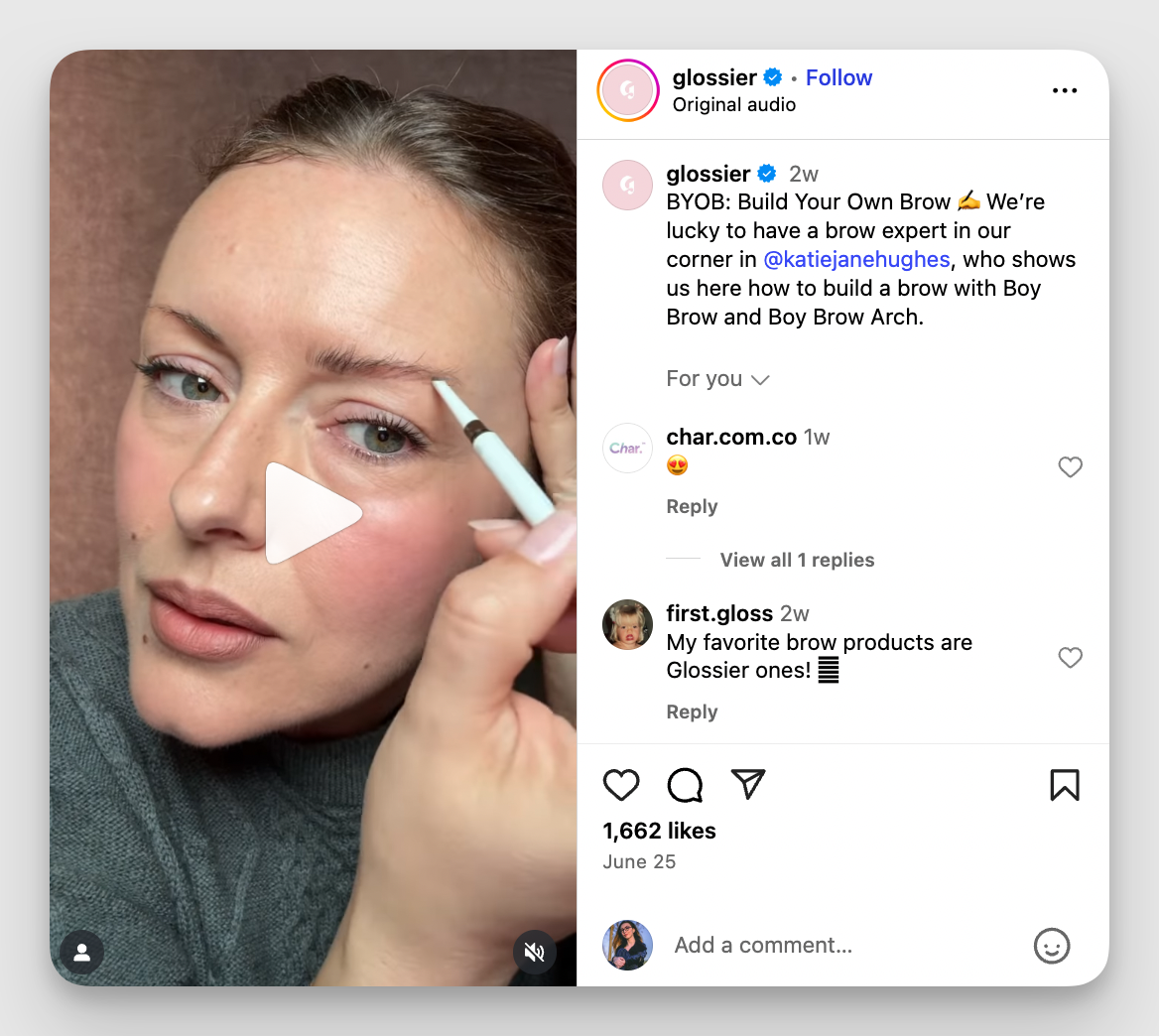
Here are some tips to make your brand more authentic on social media
- Partner with micro influencers: Smaller creators often have higher engagement and stronger social media community trust. Choose creators that align with your brand values and talk like your audience.
- Prioritize user-generated content (UGC): Repost real customer photos, reviews, and video reactions. Make it easy for users to tag you and share their experience.
- Keep your content honest: Avoid overly scripted messaging. You should sound like a human, not like a press release.
- Show behind-the-scenes moments: Give your followers a look at office culture, product packaging, and team shoutouts. These glimpses build an emotional connection.
For example, we, at Socialinsider, often share behind-the-scenes glimpses of our office life, including team traditions and everyday moments. It's always good to put real faces behind the brand.
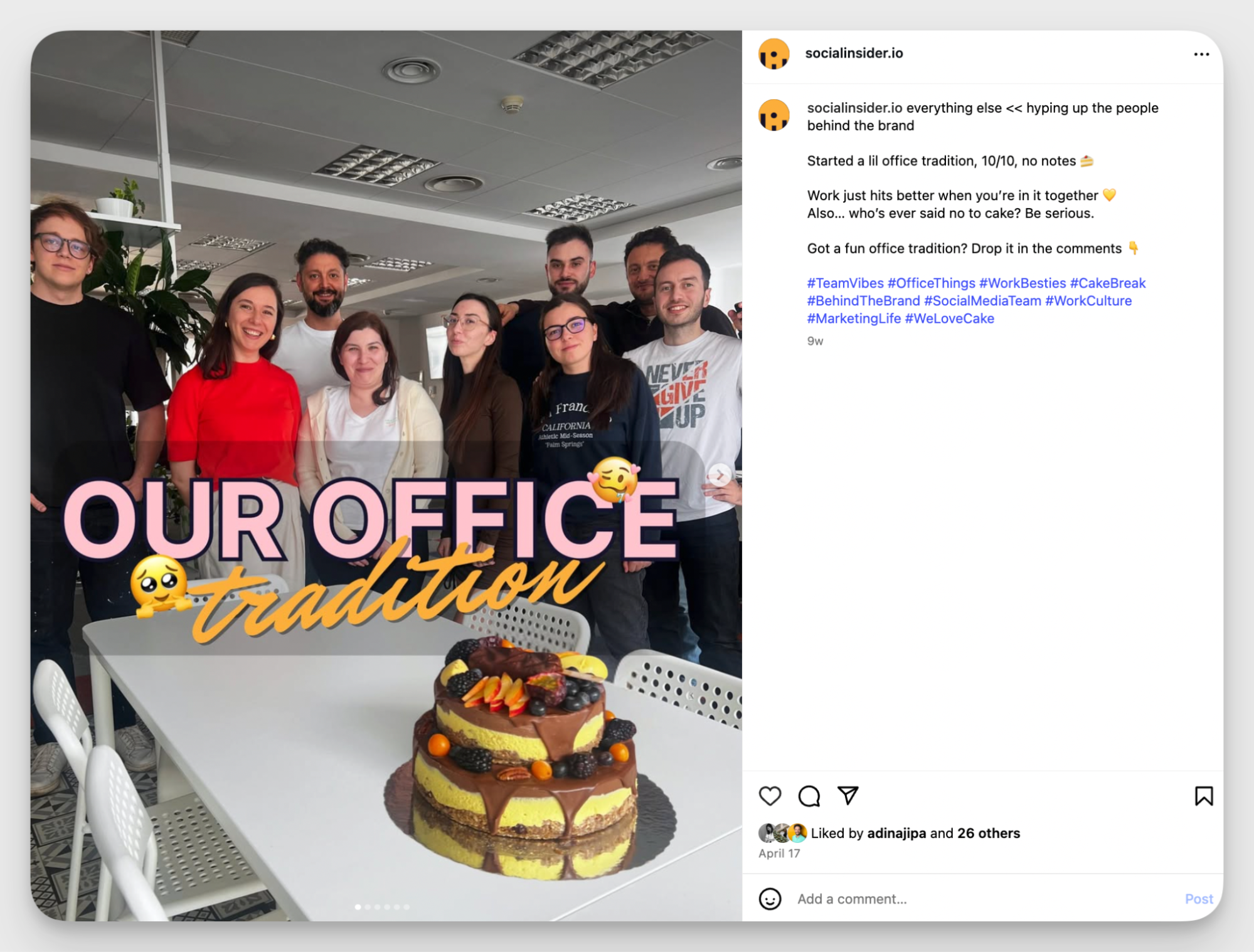
How likes, shares, and comments trigger purchasing decisions
Engagement metrics such as likes, shares, and comments may not directly lead to sales, but they are psychological validators that give users the confidence to buy based on what other people have already approved, discussed, or recommended.
Each metric taps into a different layer of buyer psychology, and together they create powerful conversion signals.
Likes/hearts: the instant validation metric
Likes are the fastest form of social proof. When users see a post with hundreds of likes, they will automatically perceive the brand as popular and trustworthy. It makes them more likely to engage or make a purchase.
As per Socialinsider’s social media benchmarks report, TikTok gets 9x more likes than Instagram, with an average of 3,092 likes per post. In fact, likes on TikTok have increased by 30% YoY.
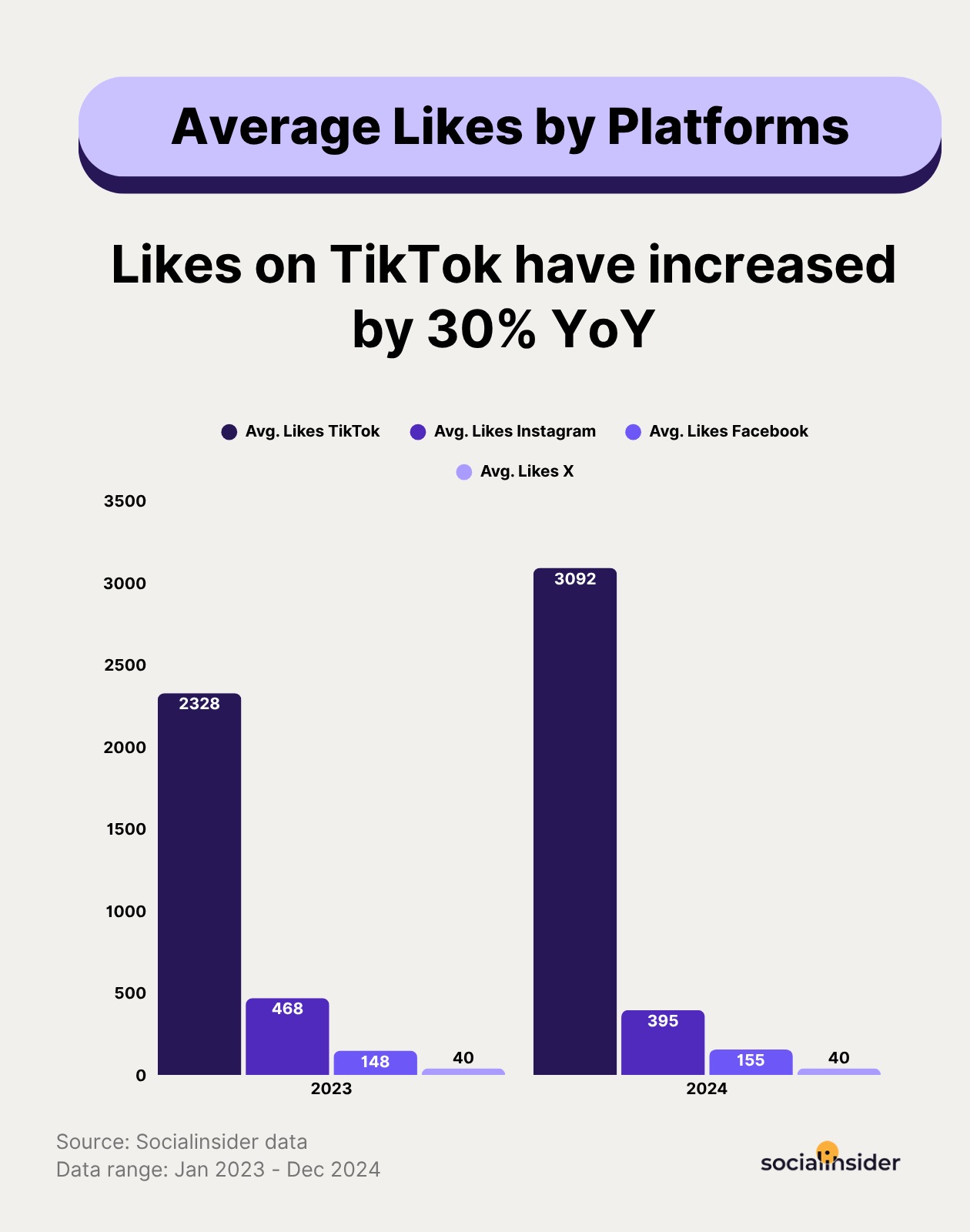
Shares/ reposts: the advocacy signal
Shares work as active endorsements as users consider your content valuable enough to pass it on to their own network. It is just like digital word-of-mouth marketing.
Socialinsider’s report also revealed that TikTok content spreads faster than any other platform. Shares on TikTok have doubled YoY, with the average TikTok post getting around 170 shares.
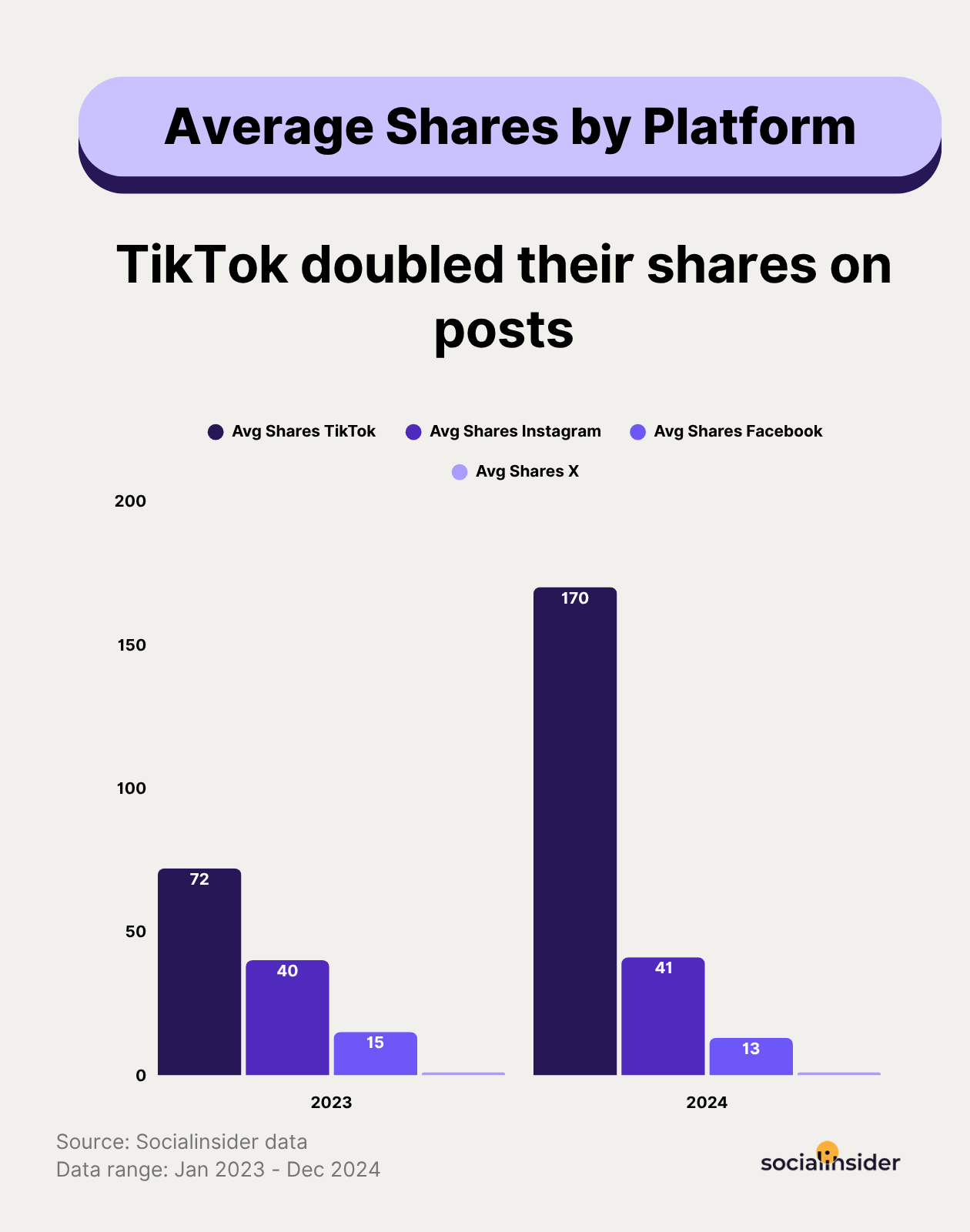
Comments: the engagement quality indicator
Comments signal that a post sparked a reaction strong enough to get a reply from users, whether it’s curiosity, appreciation, or anger. This makes comments one of the most reliable indicators of content quality.
In 2025, TikTok leads all platforms in comment engagement. The average TikTok post receives 66 comments, up 73% YoY.
Instagram trails with an average of 24 comments per post, a 33% increase from last year.
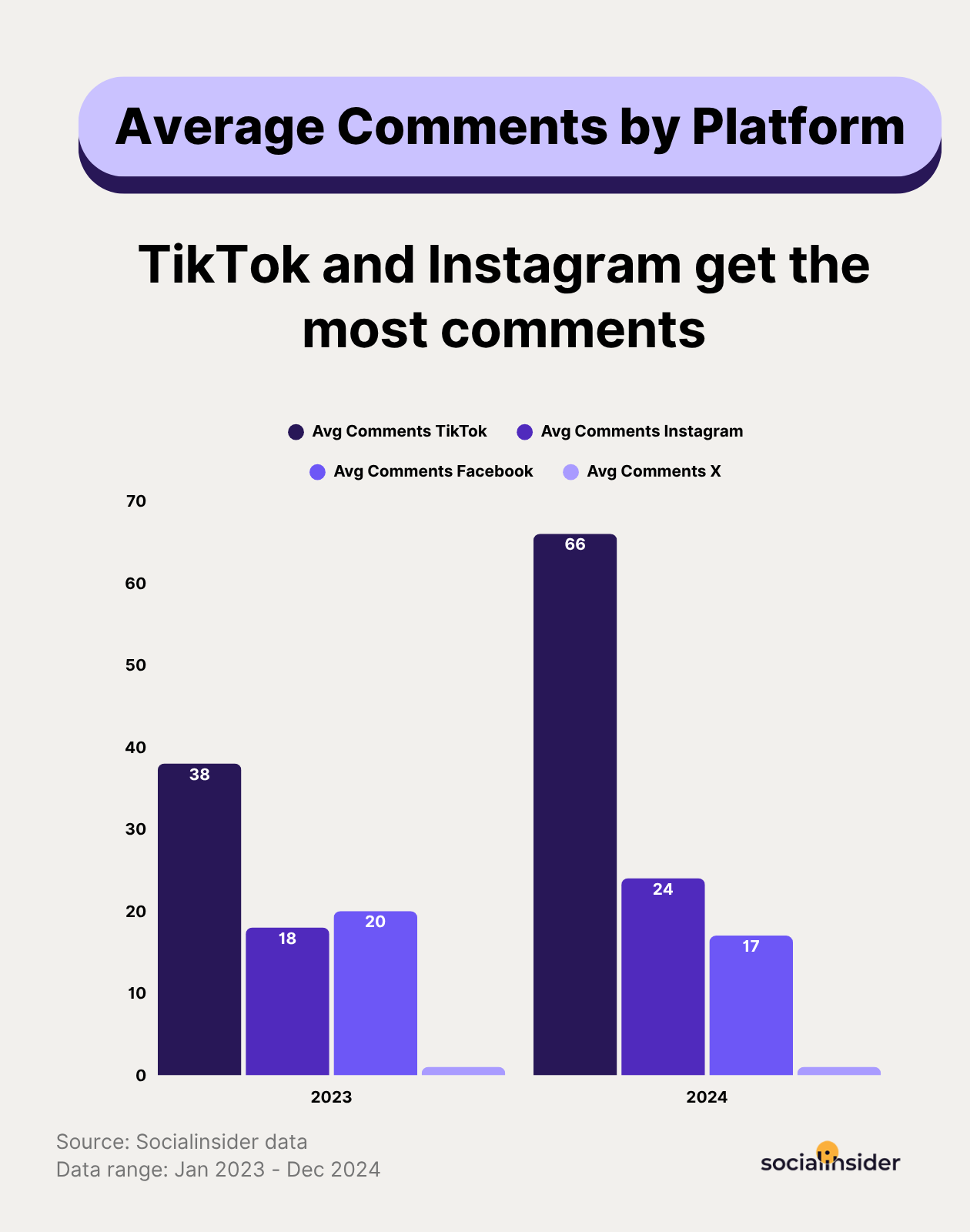
What are the platform-specific consumer behavior patterns
Instagram has evolved beyond curated feeds. It is now a full-fledged social commerce engine where brands can easily take customers through the entire discovery-to-purchase journey.
With 44% of Instagram users shopping on the platform every week, it’s now one of the most conversion-friendly platforms for consumer brands.
There are several ways brands can drive sales from Instagram. Here are the platform's top shopping features:
Instant checkout shopping tendencies are constantly increasing
Brands can tag up to 20 products in their carousel posts to make it easy for users to explore and purchase within the app.
Instagram’s highly visual nature encourages impulse purchases, which 46% of Instagram users admit to making.
When users see aesthetically pleasing product photos or Reels on their feed, the instant checkout feature allows them to act instantly on that impulse without ever leaving the app. This directly reduces the chance of second-guessing or cart abandonment.
Reels are used as a disovery tool
Reels are now one of the most consumed content formats on Instagram, driving more impressions for small accounts. They are ideal for showcasing products in action and driving impulse purchases, which 46% of Instagram users admit to making.
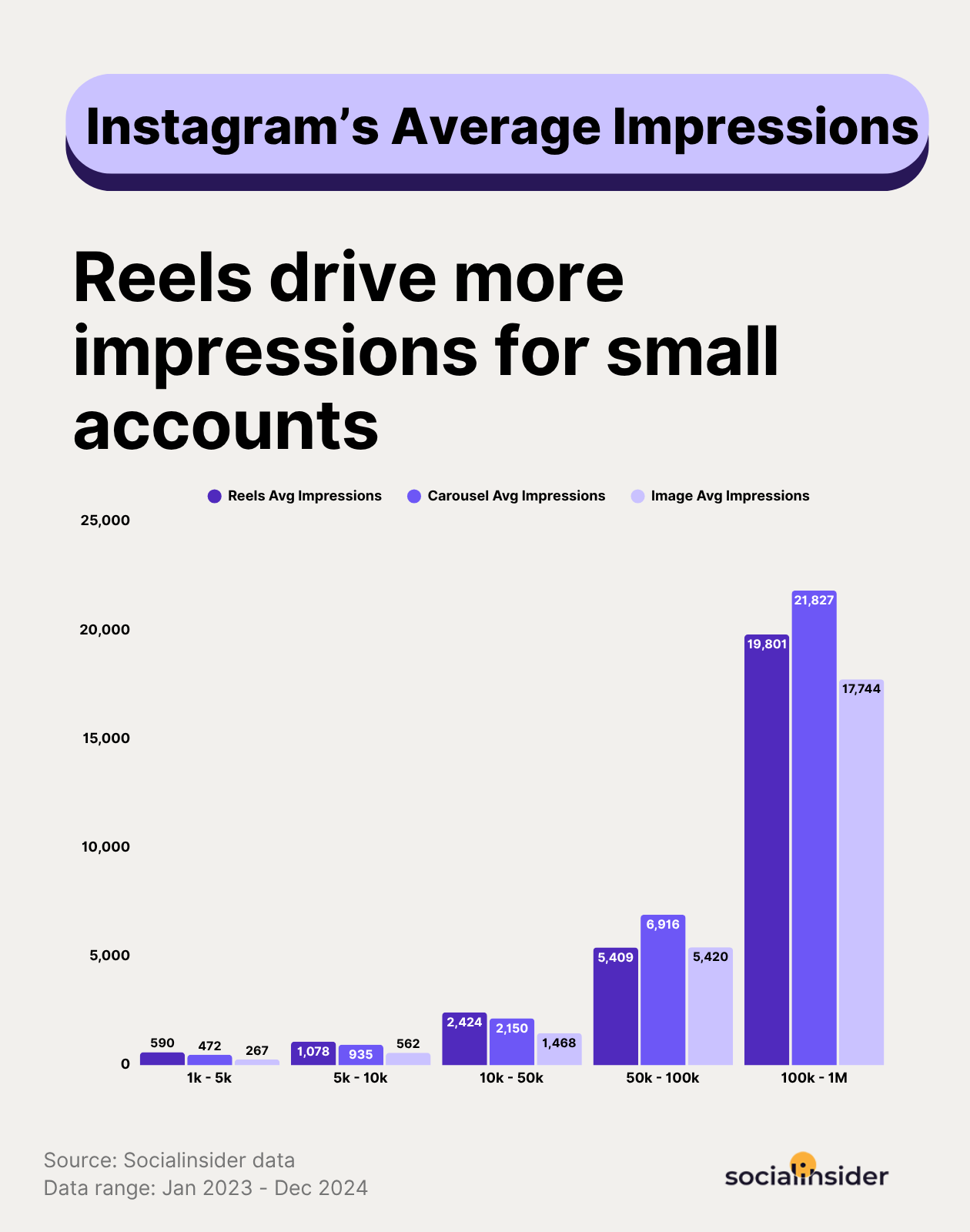
DM shopping habits are more prominent
For small businesses and service-led brands, DM-based shopping adds a personal, high-touch experience. Users can ask about sizing, availability, or pricing, and even complete a purchase directly within the chat.
Instagram also offers Order and Pay via DM in some regions, streamlining the process further. This builds trust while closing sales quickly, especially for limited-stock or customized products.
TikTok
With over 1.5 billion users, TikTok is now the perfect place for brands to target Millennials and Gen Z consumers. Over 58% of TikTok users use the platform for shopping. The gross merchandise value (GMV) for TikTok Shops has increased from $1 billion in 2021 to $33 billion in 2024.
TikTok's strength lies in its relatable creators, authentic storytelling, and smart captioning.
Spread of the #TikTokMadeMeBuyIt trend
#TikTokMadeMeBuyIt is a viral hashtag used by people when they purchase a product after seeing it in a TikTok video.
The hashtag is also used by brands when sharing user-generated content or by influencers when they share sponsored content. In recent years, this trend has had a significant impact on consumer behavior.
Products like Dyson Airwrap, Uniqlo Shoulder Bag, and Stanley Cup have gone viral on the platform, which has led to a significant increase in their sales.
For example, take a look at the TikTok account, @mylightstore.

While most videos average ~3K views, posts with the #TikTokMadeMeBuyIt tag received over 25 million views and 2.2 million likes.
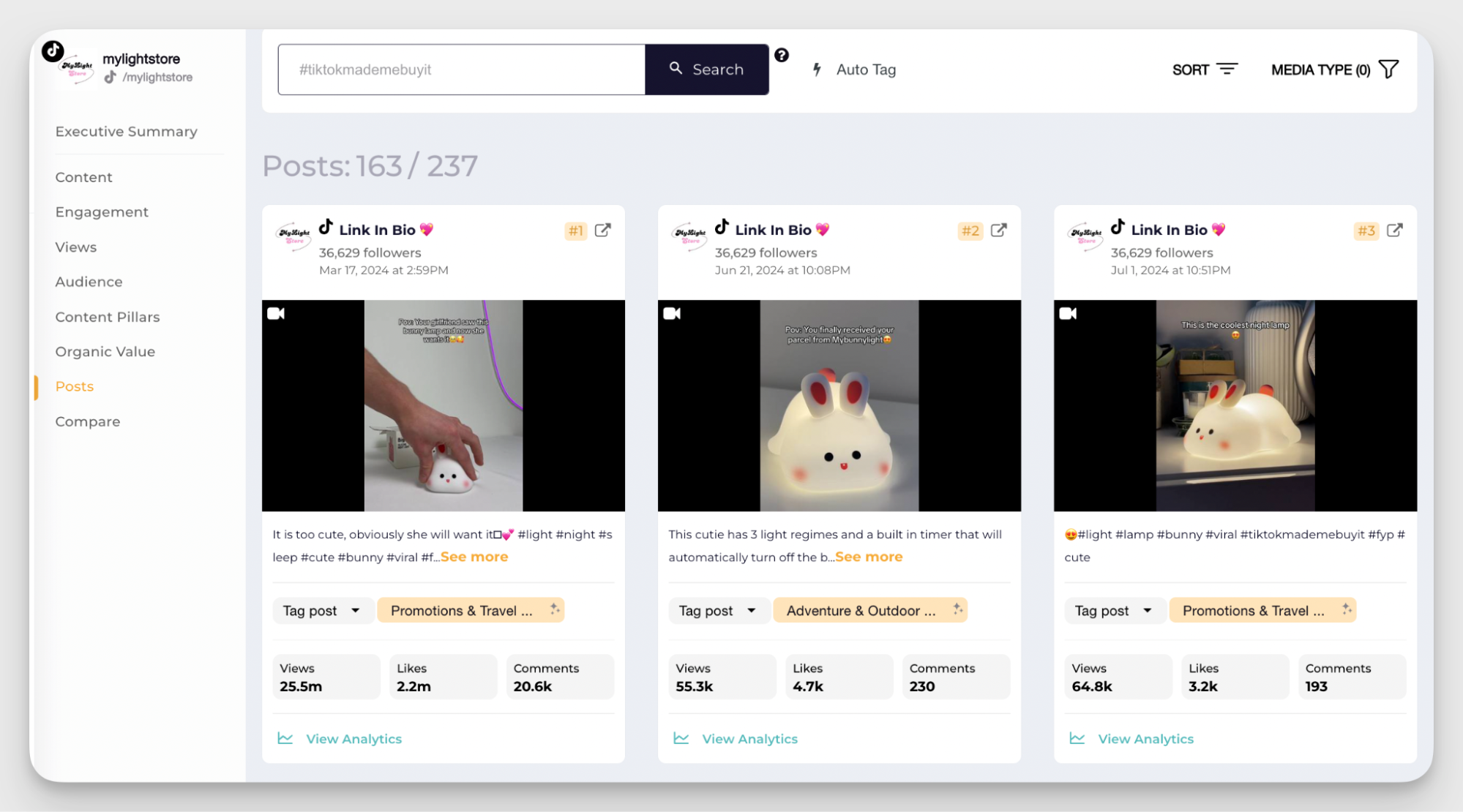
Consumer's decision speed is influenced by the consumption of short-form videos
Short-form videos on platforms like TikTok can directly impact purchase intent and decision speed due to three main factors:
- Usefulness: Useful videos (like quick demos or how-tos) give viewers exactly what they need to say yes.
- Ease of use: Concise, visually clear content lowers friction, so users don’t overthink or scroll past your content.
- Entertainment: Videos with humour, storytelling, or viral trends spark emotional reactions that lead to faster, more impulsive decisions.
By decreasing the time between interest and action, short-form videos help shrink your sales funnel.
Remember, your TikTok videos should sell trust before they sell products. The more your content feels relatable and real, the faster it encourages your audience to make a purchase.
While newer platforms get the hype, Facebook continues to own a big share of global ad budgets, and for a very good reason. The platform still sees high engagement on ads and groups.
Consumers are still highly influenced by ads
With over $123 billion in ad revenue projected for 2025, Facebook continues to be one of the leading platforms for digital marketers. In fact, 40% of businesses consider it their most profitable ad channel, and 29% of marketers say it delivers the best ROI.
With an average CPC of $0.77 and a CTR of 1.4% for traffic campaigns, Facebook offers a cost-effective way to get in front of users who actually engage with content.
The average user clicks on 12 ads per month, indicating consistent interaction with paid posts.
Formats like carousels, instant experiences, and collections let you showcase multiple angles or use cases of your products, while reducing friction between interest and purchase. You can also use retargeting or lookalike audiences to reach users in different stages of the funnel.
Participation in Facebook niche groups
With 1.8 billion people using Facebook Groups every month, there’s a niche community for nearly every product category–from fitness and parenting to gadgets and skincare. These spaces have become trusted hubs where people ask questions, get advice, and recommend products.
When someone sees a product organically mentioned or recommended by a fellow group member, it usually has more influence than a branded message. Group mentions and tagged posts often feel more credible and can accelerate purchase decisions, especially for niche or high-consideration products.
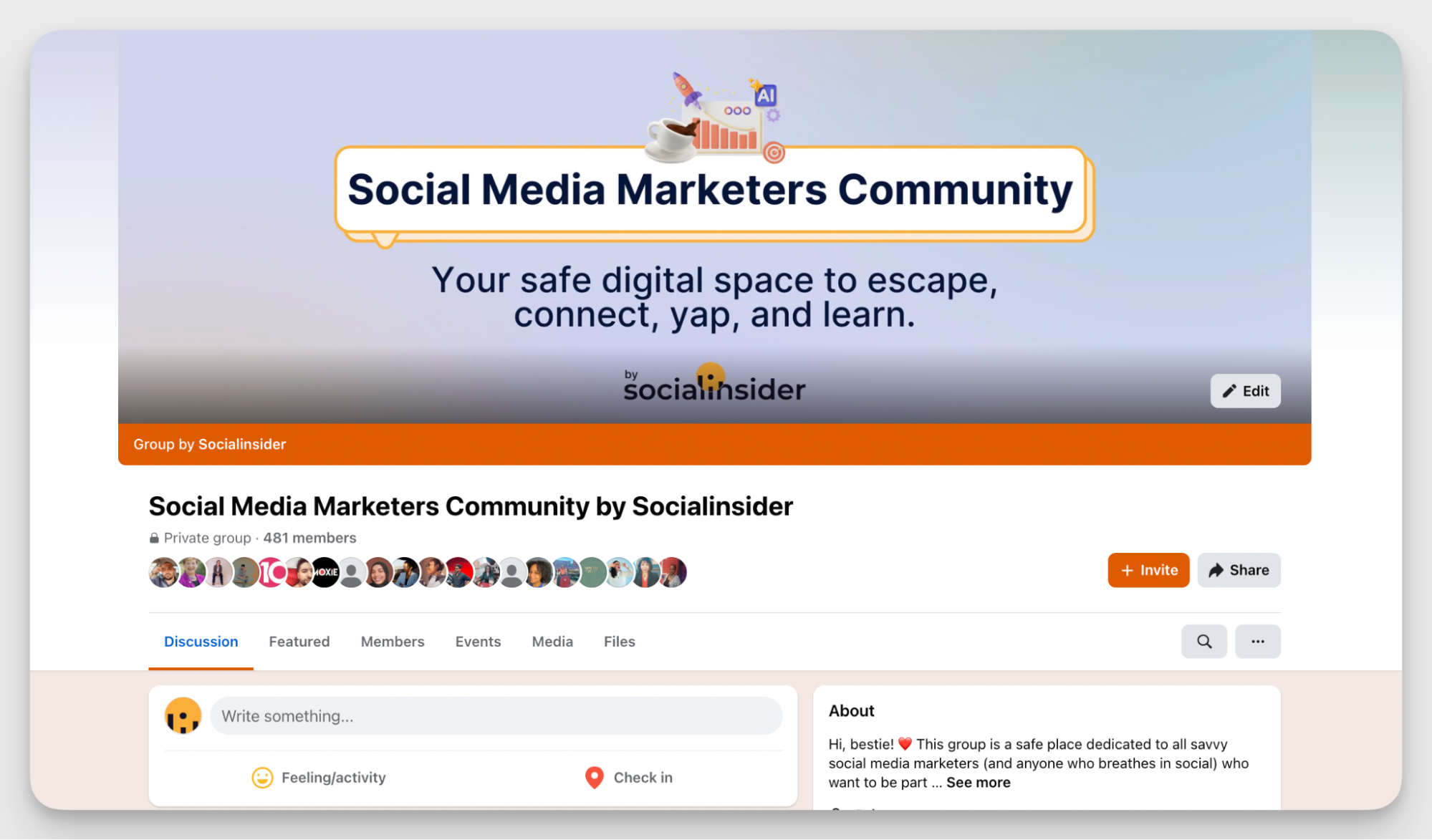
But tapping into Facebook Groups can sometimes be tougher than creating a successful Facebook ads campaign. You need to show up in relevant groups with helpful insights, all without being too salesy.
You can also look for positive brand mentions in these groups and re-share them across your brand’s social media and landing pages.
Over the last few years, LinkedIn has become the ideal platform for B2B lead generation. It’s where people come to connect, learn, and do business. That means your content, ads, and outreach can land in front of your audience with just the right context.
With features like lead gen forms, Sales Navigator, and conversation ads, you can capture leads and nurture them, all without leaving the platform.
Thought leadership content is increasing
On LinkedIn, buyers don’t want to be sold to. Instead, they want to learn from someone who gets it. That’s why thought leadership content works well on LinkedIn.
Peter Caputa, CEO of Databox, uses LinkedIn to share practical insights that resonate with his target audience, marketing the brand without relying on ads.
His profile, posts, and cover image all align with Databox, turning his feed into a soft funnel without ever feeling salesy.
Now, Peter’s personal LinkedIn profile generates around 100 free trial sign-ups for Databox, every month.
Consumers look for employee advocacy
Customers don’t just evaluate your brand, they also pay attention to the people behind it.
Especially in B2B, customers often check employees’ LinkedIn profiles to assess whether a brand is authentic, experienced, and trustworthy.
In fact, many B2B customers see employee-generated content as more credible than official brand messaging because the former feels less scripted and more rooted in real experience. And with LinkedIn’s algorithm favouring individual profiles over company pages, these posts often get more reach too.
To get employee advocacy right, make sure to encourage your team to post their wins, learnings, and processes instead of just resharing company content. Celebrate team posts on your brand page to reinforce your values publicly.
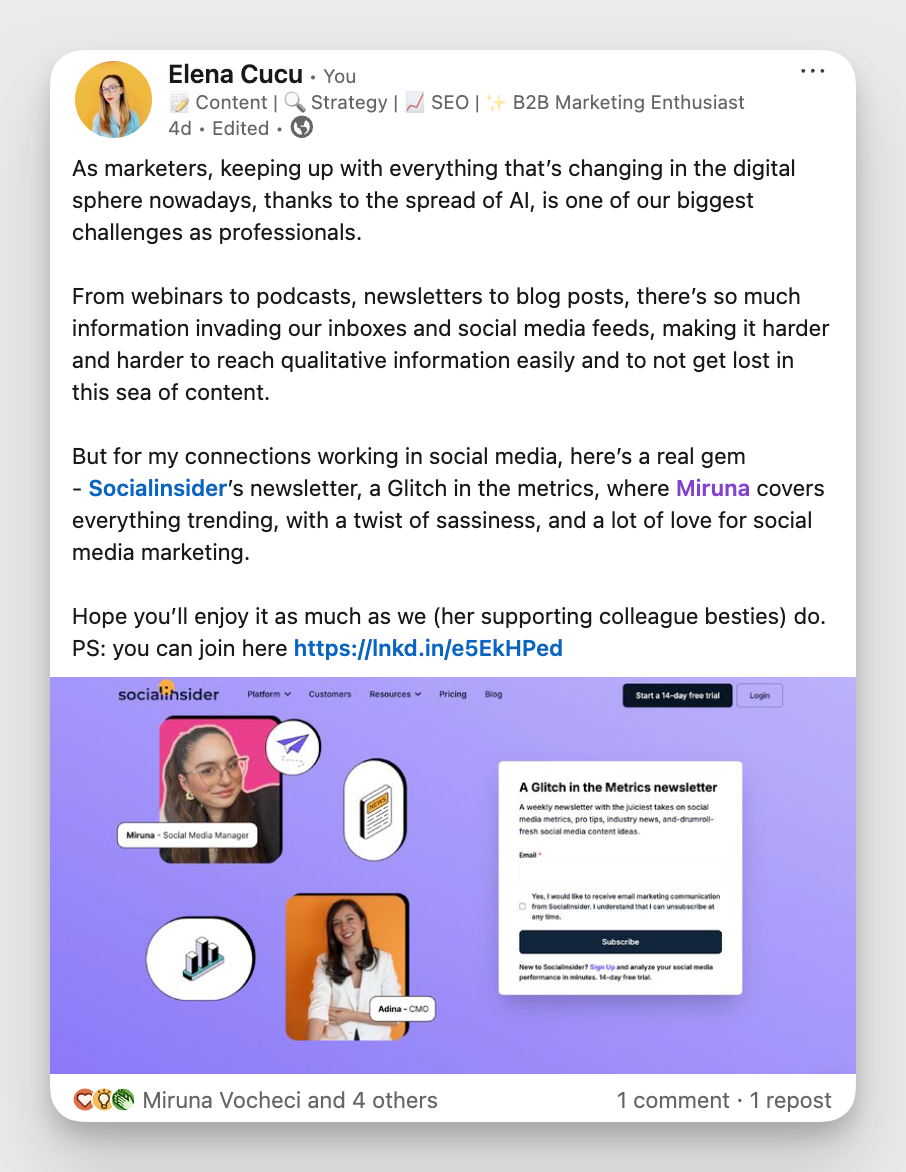
YouTube
YouTube is where people turn when they want to dive deep into product research. That makes it the ideal platform for products that require more explanation, validation, or education. In fact, 70% of users say they have purchased products they found on YouTube.
Consumers look for tutorials and review videos
Long-form videos on YouTube can directly impact more thought-out purchases. Tutorials, product walkthroughs, and in-depth comparisons give users the information they need to feel confident to place an order. A strong review from a credible creator can be as persuasive as a sales call, minus the pressure.
Unboxing and validation culture has a grerat impact on perception
Unboxing videos walk viewers through the entire product experience, right from packaging and first impressions to setup and actual usage. This helps reduce uncertainty and answer unspoken questions like: What’s in the box? Will it work as expected? Does it feel premium?
Consumers look for reliablity
YouTube videos can be a great way to improve product reach and experience, as they can put your products in front of the right audience.
Instead of leading with a sales pitch, plan your content around the real challenges your customers face.
For instance, Ahrefs uses its YouTube channel to share value-driven videos around core challenges its audience faces, like SEO strategies and Google Updates, and naturally shows how Ahrefs fits in. That balance of education and soft product placement builds both authority and demand.
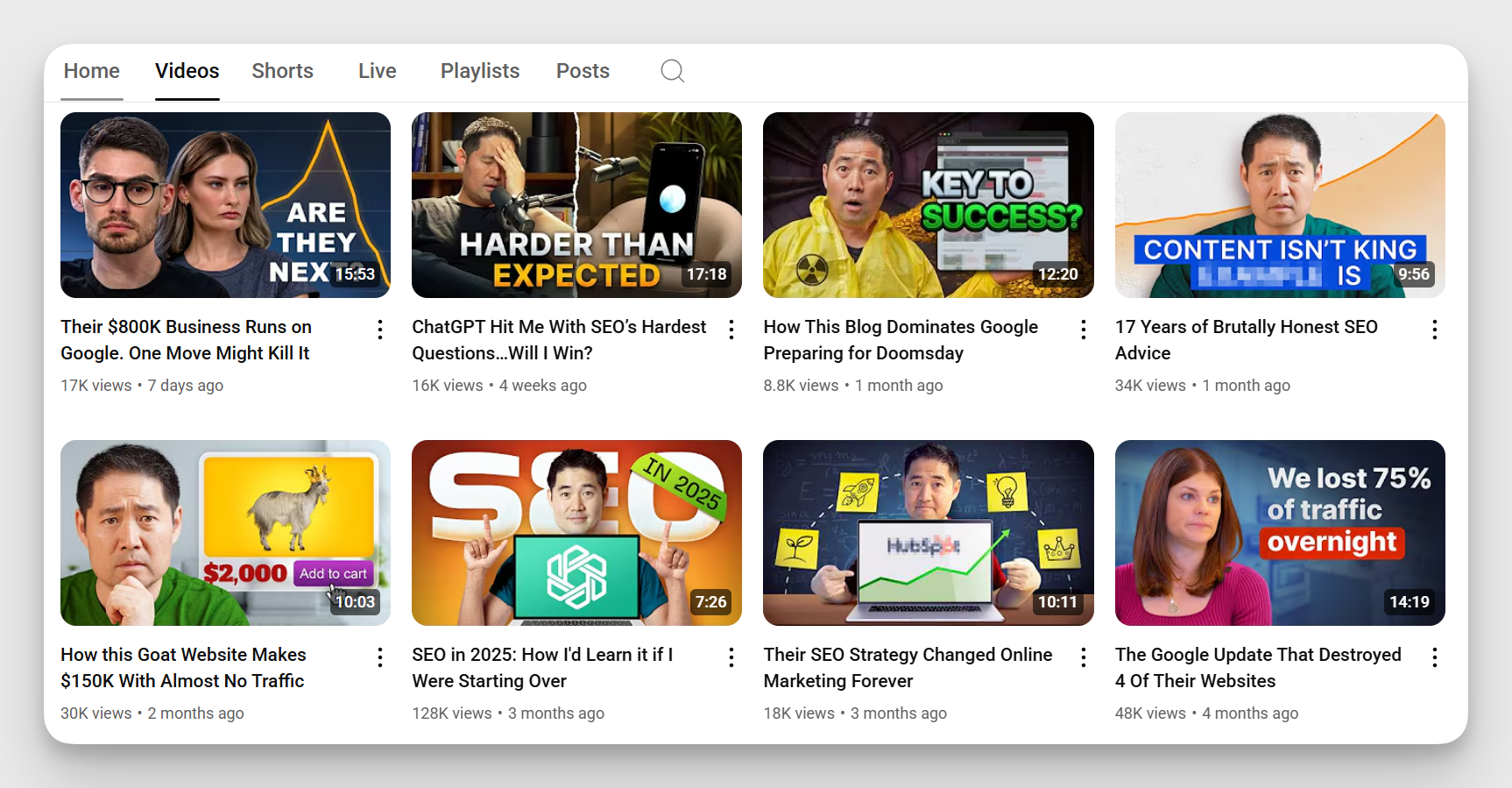
What’s the role of social media across the buyer’s journey?
Social media isn’t just for top-of-the-funnel brand awareness. When executed properly, your social media strategy can target users at every stage of the buyer's journey. Here’s how you can do that:
Awareness stage
The awareness stage is where potential buyers first discover your brand. The goal isn’t to sell, but to grab attention.
Use the latest trending TikTok sounds, reshare a customer’s Instagram Reel featuring your products, or post some thought-provoking content on LinkedIn. Brands that tap into trends tend to see the best results. That means participating in the conversation without hijacking it.
Consideration stage
At this stage, users are already considering making a purchase. Customer reviews, replies from the brand, and influencer collabs can help shape their decision. When hesitant users get quick responses to their DMs or comments from the brand, it makes them more confident to place an order.
Purchase stage
Shoppers are ready to buy at this stage, but cart abandonment can be a major challenge if you don’t optimize all the touchpoints.
So instead of sending users from your social media ad to your website, you can set up native checkouts to keep them inside the app. It reduces extra clicks and mental effort, significantly lowering the chance of abandonment.
Loyalty stage
The loyalty stage is where happy customers turn into repeat buyers and brand advocates.
Make sure to always respond or reshare customer reviews to acknowledge your customers and validate their choice.
At the same time, keep encouraging user-generated content (UGC) and asking for feedback. It builds a library of social proof that new buyers rely on when making their own decisions.
How do different content types influence purchase behavior?
Not all content is created equal, especially when it comes to driving sales. Here’s how two of the top content types impact purchase behavior:
UGC
UGC shows how real people use a product in everyday life. It answers the same questions customers are already searching for on platforms like Reddit: Will this work for someone like me? Does it look the same outside of a product shoot?
And when customers get to visualize the product in action, they automatically feel more confident and are more likely to complete the purchase.
UGC also has a longer shelf life. You can repurpose it for ads, product pages, and email campaigns to nudge hesitant buyers and reduce decision fatigue.
Influencer marketing
People turn to influencers not just for product recommendations, but because they trust the opinions of these influencers and see them as part of their extended online circle.
They often feel personally connected to nano influencers (1,000-10,000 followers) and micro-influencers (10K–50K) because these smaller creators share relatable content, interact with their audience more often, and come across as everyday people
That’s also why nano and micro-influencers often outperform big-name endorsements. Their audiences are smaller but more engaged and conversion ready.
Posts from nano influencers get a 7% conversion rate per engagement, which is almost double that of micro influencers.
Celebrity partnerships work well for broad awareness campaigns, which are aimed at improving brand reach.
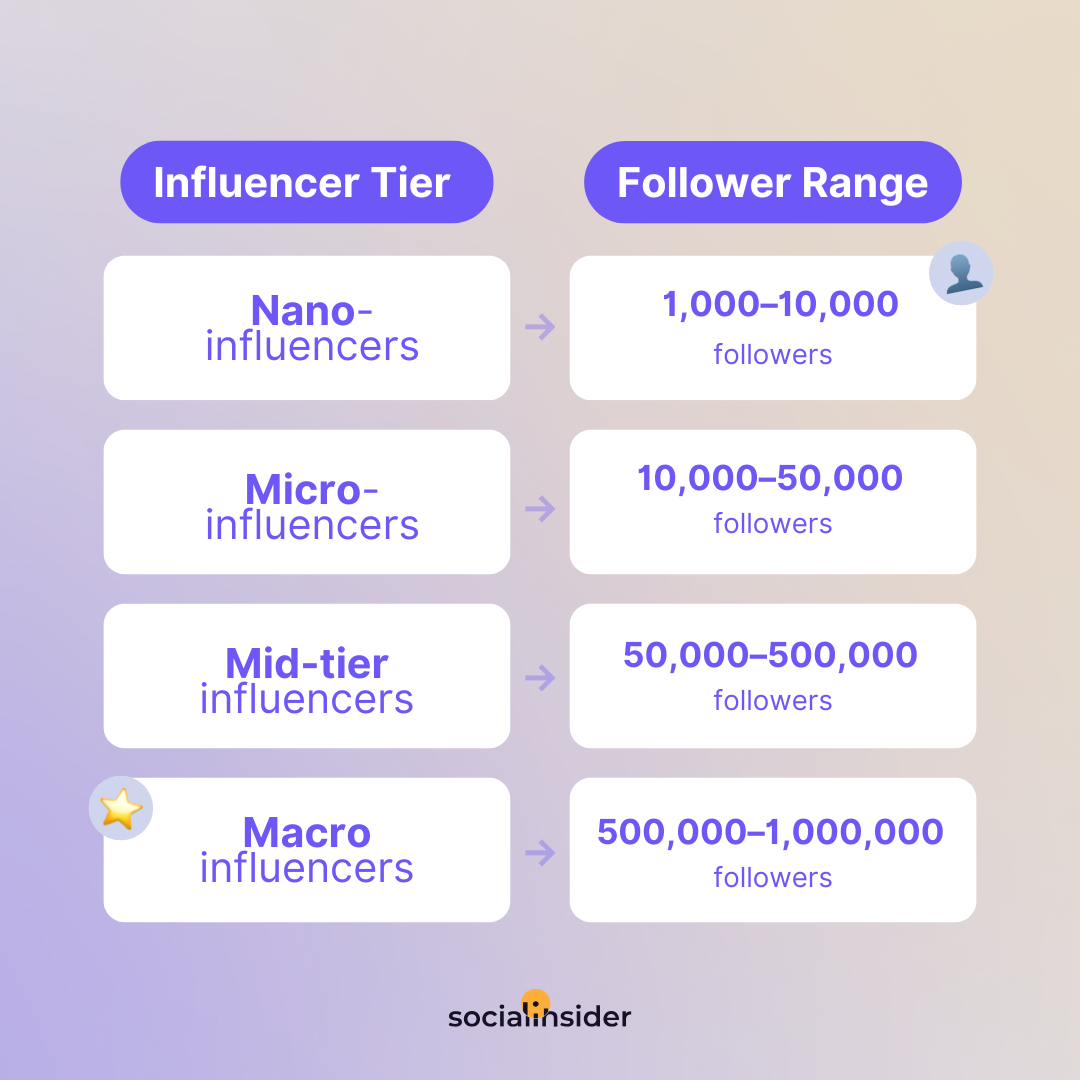
How to measure the impact of social media on business objectives?
To measure the impact of social media on business outcomes, analyze the main metrics that connect engagement to revenue.
Here’s what to track:
- Social commerce conversion metrics: You need to track how many users actually complete a purchase after interacting with your social content or ads. Measure click-throughs, add-to-carts, and checkouts from in-app shops or your campaign URLs.
- Engagement-to-sale correlation: Analyze how engagement metrics (likes, comments, saves) correlate with trial signups, demo requests, or purchases.
At Socialinsider, for instance, LinkedIn is our most impactful social channel. We monitor closely, regularly adjusting social media campaigns, reviewing monthly engagement data, and tracking how many new customers come through social media each month.
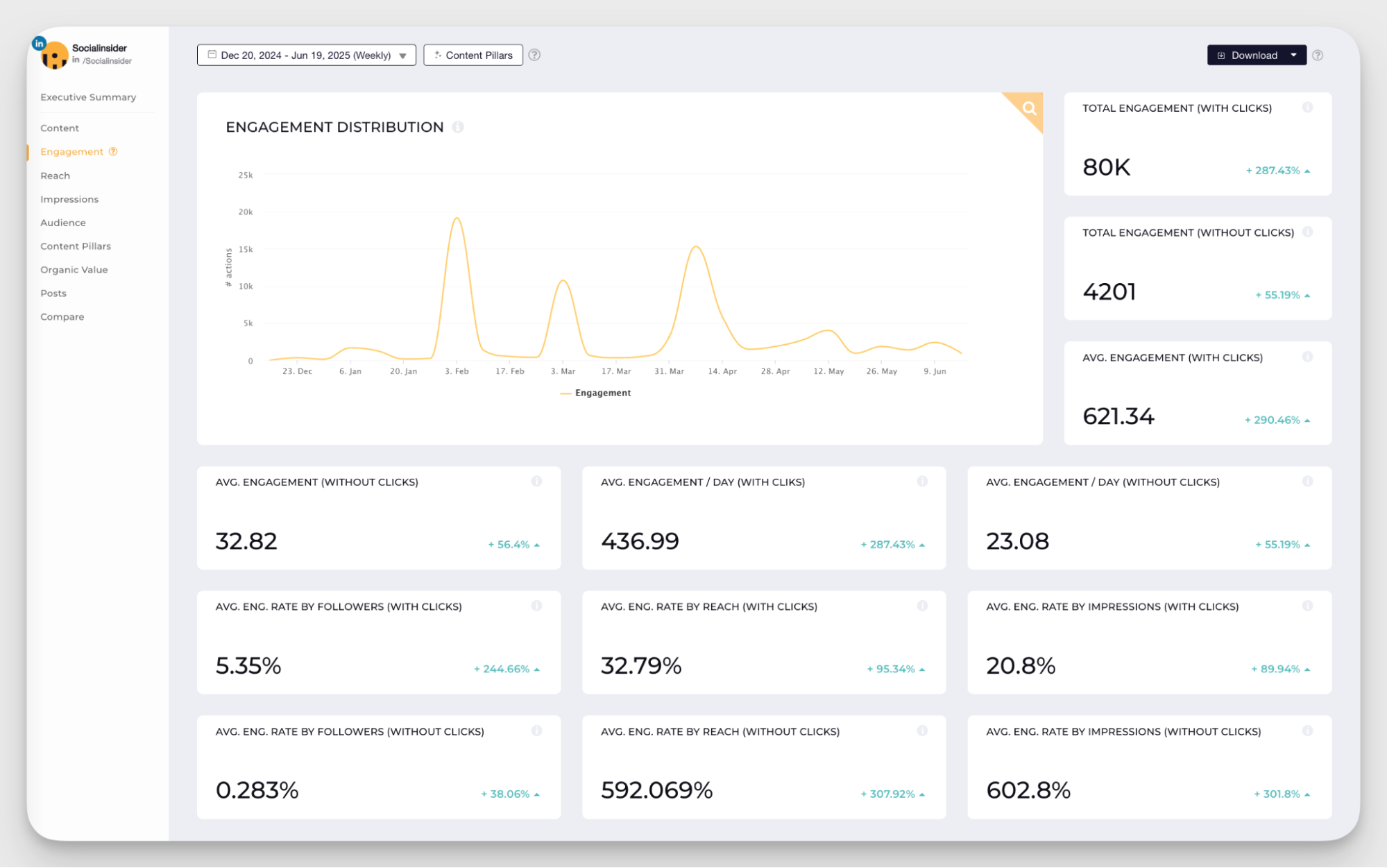
We also ask new customers how they heard about our tool.

- Customer lifetime value (CLV) from social: Calculate how much revenue, on average, a customer acquired through social media brings in over their entire relationship with your brand. This can help you understand if your social channels are attracting high-value customers or just quick wins.
What tools to use to analyze consumer behavior on social media?
Understanding what your audience loves and what makes them convert starts with using the right tools. Here are the top tools you can consider for social media audience analysis:
Social media analytics tools
Best option: Socialinsider
Socialinsider is a competitive benchmarking and social media analytics tool designed to help brands and agencies improve their content strategy, track performance, and gain a competitive edge.
Here’s how Socialinsider can help:
- Identify the best-performing formats: Learn whether your audience prefers Reels, carousels, long-form, or short-form videos to create the right content mix.
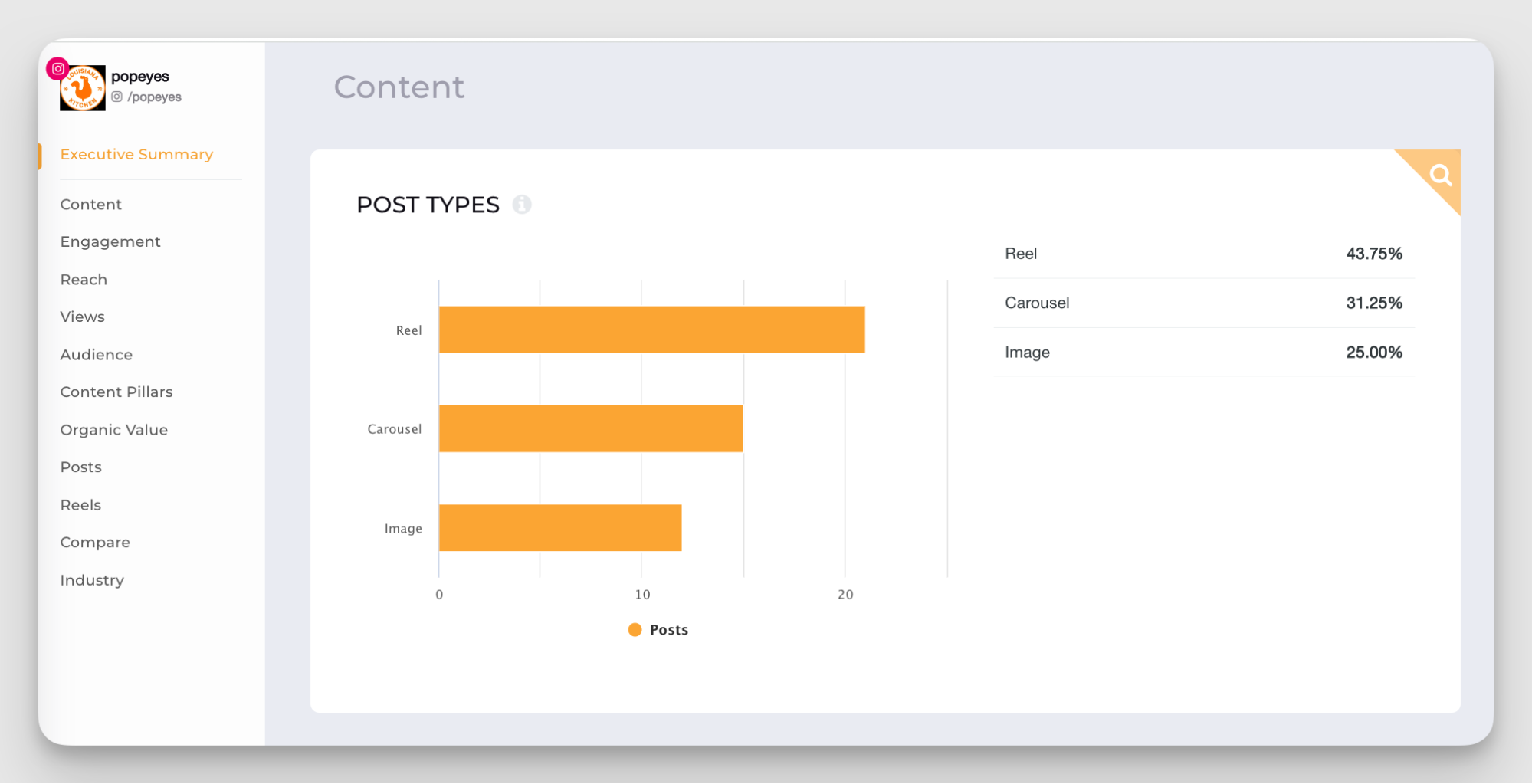
- Find your most effective content pillars: Understand which content pillars (education, behind-the-scenes, promotions) your audience is most drawn to.
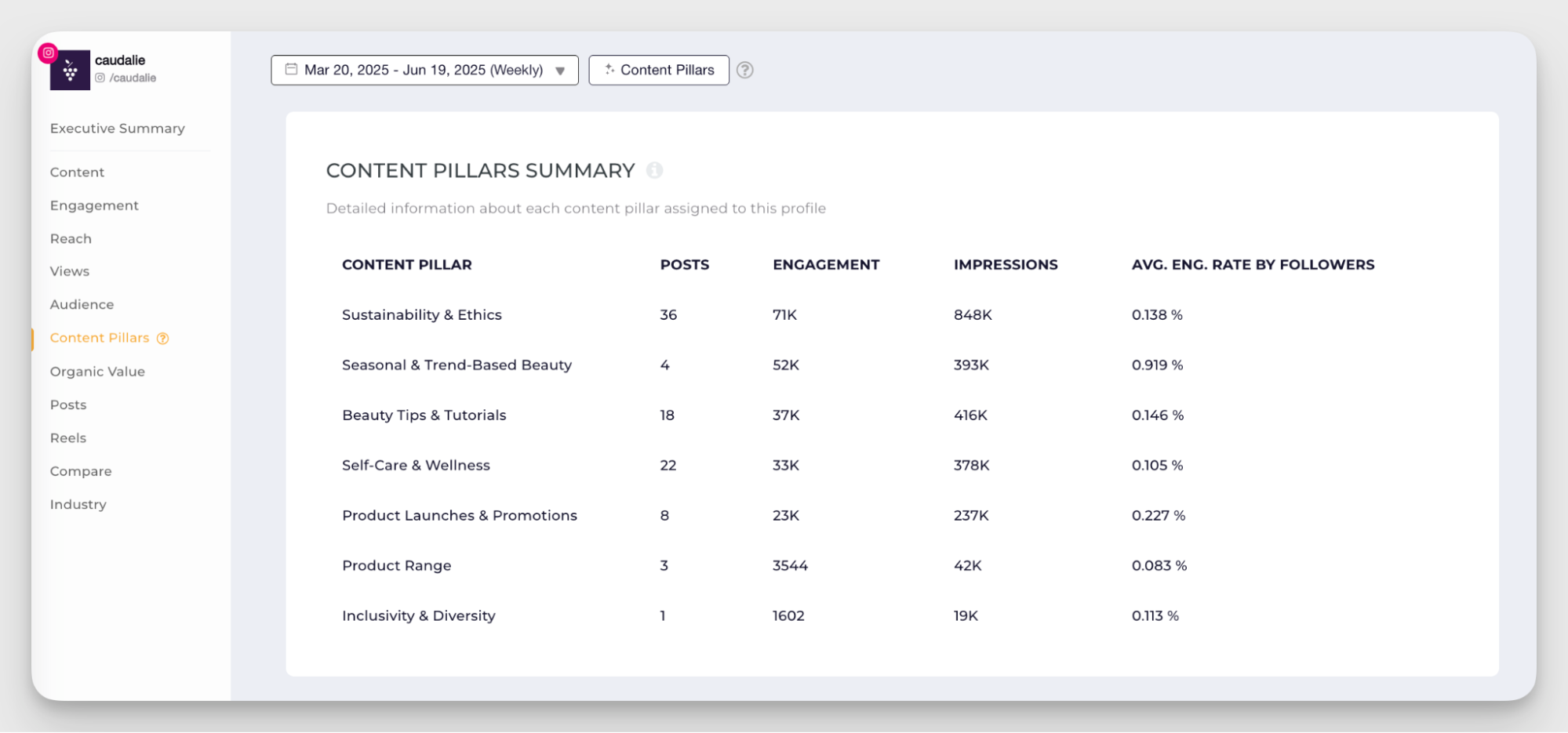
And while we're at it, let me give you a real-life example of Socialinsider's helpful capabilities.
Riley, who leads the social intelligence data team at Tink Jam, chose Socialinsider for its cutting-edge analytics and ability to save valuable time for her and her analysts. “Socialinsider supports TikTok analytics—and you’d be shocked by how many social analytics tools do not support TikTok,” she shared.
Having access to advanced tools and comprehensive cross-platform insights, Riley’s team can focus on strategic work instead of manual data gathering, further validating Socialinsider’s effectiveness for data-driven teams.
Social media listening tools
Best option: Mentionlytics
Mentionlytics helps you understand what your customers really think and say about your brand.
The AI-powered social media monitoring tool tracks brand mentions, competitor mentions, and trending keywords across platforms so you can spot what people love, what’s bothering them, and how you stack up against other competitors in the industry.
What emerging trends are shaping consumer behavior further?
Consumer behavior is evolving alongside technology, and platforms are quickly adapting. Here are the top trends shifting consumer behavior:
AR/VR and virtual try-ons
With augmented reality (AR) and virtual try-ons, customers can experience the product in their own space, whether that’s trying on glasses or checking a new lipstick shade.
Platforms like Instagram, Snapchat, and even Shopify are increasingly integrating AR filters and 3D product previews directly into their shopping experiences so customers can try before they buy, without ever leaving the app.
Platforms like Instagram, Snapchat, and even Shopify are increasingly integrating AR filters and 3D product previews directly into their shopping experiences so customers can try before they buy, without ever leaving the app.
Live shopping and real-time commerce
Live shopping combines entertainment, urgency, and authenticity, especially when the host is a creator the audience already trusts. Viewers can watch a product demo, ask questions in real-time, and make a purchase during the stream.
TikTok Shop Live, Facebook Live Shopping, and Amazon Live are already leaning hard into this trend.
Final thoughts
Understanding social media consumer behavior isn’t just an advantage—it’s the foundation for meaningful connection and lasting impact.
The patterns we uncover, the trends we anticipate, and the insights we put into action can completely transform the way we lead our teams and build our brands.
As I’ve learned, staying curious and committed to this ongoing discovery is what empowers us to not just keep up, but actually set the pace. By making consumer behavior the heart of your strategy, you’ll be ready to adapt, inspire, and achieve results that truly matter—in every campaign and every conversation.
Analyze your competitors in seconds
Track & analyze your competitors and get top social media metrics and more!
You might also like
Improve your social media strategy with Socialinsider!
Use in-depth data to measure your social accounts’ performance, analyze competitors, and gain insights to improve your strategy.



